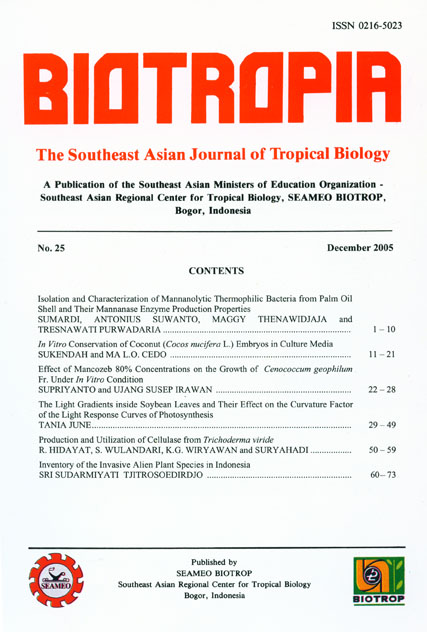
Tags
THE LIGHT GRADIENTS INSIDE SOYBEAN LEAVES AND THEIR EFFECT ON THE CURVATURE FACTOR OF THE LIGHT RESPONSE CURVES OF PHOTOSYNTHESIS
Content Language : English

Light gradients within leaves are not included in the model of Farquhar, although a steep light
gradient does exist within leaves. For a bifacial leaf, the model shows good agreement with measured
data, but for an isobilateral leaf the model may underestimate photosynthesis measured by conventional
gas exchange. Isobilateral leaves easily developed when plants were grown in growth chambers where
some light were reflected from the growth chamber metal base onto the lower surface of the leaves during
growth, resulting in adjustment of the photosynthetic capacity inside the leaves. This could also happen in
the field when canopy is very sparse and lower surface of leaves was exposed to reflected light from soil
surface. Complications occurred when fitting the light response curves of the electron transport rate, due
to the interaction between the quantum yield of electron transport (a2) and the curvature factor (Θ). It is
suspected that there may be an interaction with the light gradient within the leaf. This manuscript
discusses the effect of a light gradient inside a soybean leaf on the estimation of Θ. It is shown in the
manuscript how the light curves of the isobilateral leaves (at different degree) responded when measured
using conventional gas exchange and how it affected the estimation of Θ and the electron transport
capacity, Jmax. An experiment was conducted to prove the hypothesis that this “out of ordinary” estimate
of Θ (and hence Jmax) was due to the unmatched distribution of photosynthetic capacity with distribution
of absorbed light.
Link

This work is licensed under a Creative Commons Attribution-NonCommercial-NoDerivatives 4.0 International License.
